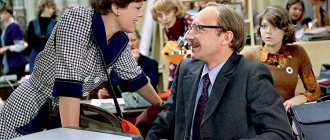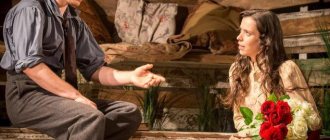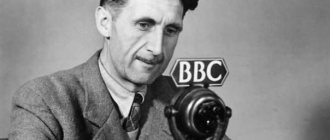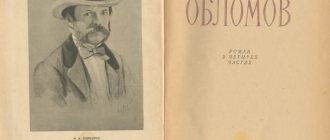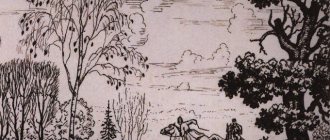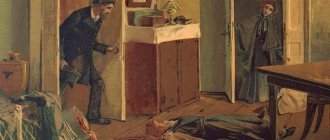Chief Bromden quotes from One Flew Over the Cuckoo's Nest (1962)
Interesting thoughts from Chief Bromden about the Combine, Dad, Sister Redchet and McMurphy.
Excerpts from the novel by Ken Kesey. You can read about Bromden himself in this article.
(about McMurphy) How did he manage to kick out? Maybe the plant didn't get to him in time - just like they did to old Pete - and implant the regulators. Maybe he grew up untamed, anywhere, drove all over the country, as a boy he did not live in one city for more than a few months, so the school did not take him into its hands, and then he felled wood, played cards, roamed with attractions, moved quickly and light and eluded the plant, so they didn’t have time to implant anything into him. Maybe that was the whole point - he eluded the plant, just as he eluded the orderly yesterday morning, not allowing him to insert the thermometer - because it is difficult to hit a moving target.
(when McMurphy was unable to strangle Sister Redchet and screamed) There was fear in him of a hunted animal, hatred, powerlessness and defiance - and if you have ever chased a raccoon, a cougar, a bobcat, you have heard that last cry of one driven into a tree, shot and falling down the animal, when dogs are already attacking him and he doesn’t care about anything except himself and his death.
(When McMurphy was turned into a vegetable) I watched them and tried to figure out what he would have done in my place. I knew one thing for sure: he wouldn’t allow someone like that, with a last name attached, to sit in the day room for twenty or thirty years and my sister would show: this will happen to anyone who goes against the system. I knew this for sure.
McMurphy doesn’t know, but only sensed what I understood long ago: the main force is not the elder sister herself, but the entire plant, a plant spread throughout the country, and their elder sister is just an important official.
If something prevents her household from functioning like an accurate, oiled, well-oiled machine, the older sister loses her temper. The slightest glitch, disorder, interference, and she turns into a white tight lump of rage, and a smile is stretched across this lump. She walks around the department, her face between her nose and chin is cut with the same doll-like smile, the same calm buzzing comes from her eyes, but inside she is tense as steel. I know this because I feel it.
This is the older sister. The black guy with the thermometer went after her. She stands there, tapping that thermometer on her watch, her eyes buzzing as she takes measurements of her new patient. Heart-shaped lips, like a doll’s, are ready to accept a plastic nipple.
Under her leadership, the inner world - the department - is almost always in full compliance. But the trouble is that she cannot be in the department all the time. Part of her life is spent in the outside world. So she is not averse to bringing the outside world into line. She works together with others of the same kind, I call them the plant - this is a huge organization that strives to bring the outer world into line in the same way as the inner one is brought into line. The elder sister is a real veteran of this business, she has been doing it for God knows how many years: a long time ago, when I came to them from the outside world, she was already the elder sister in her previous place.
Yes. I know this for sure. A department is a factory within a combine. Here the mistakes made in neighborhood homes, churches and schools are corrected—the hospital corrects. When a finished product is returned to society completely repaired, as good as new, or even better, the elder sister’s heart rejoices; what arrived dislocated, not original, is now a serviceable, fitted part, the pride of the entire team, a visual miracle. Watch how he glides along the ground with a soldered smile and smoothly enters the life of a cozy little neighborhood, where they are just digging trenches for the city water supply. And happy about it. Finally brought into compliance.
“Maybe the plant is not so omnipotent? Now we know what we are capable of, and who will stop us from repeating it?
I'm glad that McMurphy brought the orderly to the end, not many people can do that. My father knew how - then the government chiefs came to buy off the contract, but my father spread his legs, did not move his eyebrows, squinted at the sky. He squints at the sky and says, “The Canada geese are flying.” The bosses look, rustle papers: “What are you talking about? There are no... Uh... Geese at this time of year. Uh... No geese." They spoke like tourists from the east coast - they also think that you have to talk to an Indian in a special way, otherwise he won’t understand. Dad doesn’t seem to notice how they are talking. Looks at the sky. “The geese are flying, white man. Do you know what they are? This year there are geese. And last year geese. And the year before last and the year before that.”
How Ken Kesey and his novel One Flew Over the Cuckoo's Nest changed American consciousness
Ken Kesey's liberation mission began in 1960 in the southern suburbs of San Francisco. At the time, he was taking a literature course at Stanford University and working as a night orderly at the Menlo Park Veterans' Hospital. Ken's neighbor, Stanford psychology student Vic Lovell, invited the future writer to take part in a secret study of psychoactive drugs for the purpose of manipulating human behavior, which was sponsored by the CIA.
We do not know the details of this experiment, but it is obvious that, in addition to his rich psychedelic experience, Ken Kesey took from it a lot of valuable observations about the life and customs of patients and hospital staff - especially when he discovered that his key fit the lock of the head physician's office, where the drugs were kept . Kesey often talked with the residents of the hospital and gradually came to the conclusion that their illnesses were imaginary - society simply rejected any non-standard forms of thinking and behavior, branded them as pathologies and sought to expel atypical individuals from its ranks. Having refracted these observations through his rich imagination, literary talent and hefty doses of LSD and mescaline, Kesey gave birth to his main brainchild - the novel One Flew Over the Cuckoo's Nest.
Ted Streshinsky/CORBIS/Corbis via Getty Images
The Merry Pranksters led by Ken Kesey in San Francisco, 1969.
The story of a mental hospital run by a tyrannical head nurse has become a symbol of man's struggle against a rigid system, a biting metaphor for an American society enslaved by a repressive state. The novel, published in 1962, instantly became a bestseller and was staged on Broadway with great acclaim, bringing fame to its creator and, importantly, financial independence. Kesey acquired a log house in La Honda and began experimenting with “acid” with renewed vigor in the company of like-minded people. LSD sessions were accompanied by appropriate music (Kesey was especially fond of the Grateful Dead), with lighting effects and decorations, and were called “Acid Tests.”
After some time, it was decided to turn “traveling without moving” into a real trip. In 1964, Kesey's cohorts - a gang of hippies who called themselves the Merry Pranksters - found an old school bus, painted it in psychedelic colors, loaded it with equipment, costumes and substances, and headed to New York to attend the World's Fair. This journey was described in great detail and plausibly by the writer who joined them, Tom Wolfe, in the book “The Electric Kool-Aid Acid Test.”
The adventures of Kesey and the Pranksters included meeting the Hell's Angels biker gang, speaking at an anti-war rally, publicly promoting psychedelic self-discovery, and being harassed by the police - all captured on 16mm film. Returning to La Honda, Kesey and his comrades gathered to begin editing the footage. But on a beautiful April day in 1965, the police - 17 sheriff's deputies and a federal narcotics agent with a sniffer dog - burst into Kesey's house. Kesey appeared in court on marijuana possession charges, but after paying bail, he did not wait for trial, faked his death and fled to Mexico. Returning in 1966, he was nevertheless forced to appear in court and serve six months for possession of marijuana - with maximum benefit for world culture. During his imprisonment, he diligently wrote down his thoughts and drew enthusiastically, and his cellmate Page Browning secretly transferred albums with drawings and sayings to the outside, hiding them in porn magazines. After his imprisonment, Kesey moved to a remote farm, where for the rest of his earthly career he devoted himself to family life, agriculture and literature - mainly essays and plays, none of which had the effect comparable to One Flew Over the Cuckoo's Nest.
Ted Streshinsky/CORBIS/Corbis via Getty Images
People dance at an "Acid Test" party in San Francisco.
The novel was called a “rebellion against the rules” and a “roar of protest” - it came at the time of the birth of the psychedelic revolution and the beginning of the hippie movement, which promoted freedom from any restrictions. One Flew Over the Cuckoo's Nest also became a harbinger of the anti-psychiatry movement in the United States. After the book was published, archaic methods of treatment - in particular, electric shock, lobotomy and drug abuse - ceased to be the norm. Thousands of patients across America left psychiatric hospitals and, with varying degrees of success, integrated into ordinary life, and medical practices became more humane. New types of drugs were developed that allowed people with mental disorders to be treated without hospitalization, at home, and psychiatric institutions ceased to resemble prisons for the insane.
In 1963, President Kennedy initiated the adoption of the Mental Health Act, according to which psychiatric institutions moved from state to public jurisdiction, and their patients could lead full lives without being imprisoned.
In the 60s and 70s, the Anti-Psychiatric Movement developed in full force under the influence of the ideas of the American psychiatrist Thomas Szasz, who considered mental illness mythical and was a prominent critic of the use of medicine for the purpose of social control in modern society - Ken Kesey, by the way, was fascinated by his books and corresponded with him. Also significantly influential were the works of the Scottish psychiatrist Ronald David Laing and the Frenchman Michel Foucault on power and punitive medicine: The History of Madness in the Classical Age (1961) and The Birth of the Clinic: The Archeology of the Medical Gaze (1963).
Getty Images
How the lobotomy procedure was performed in 1949.
The most radical representatives of the “Anti-psychiatric movement” - for example, the Mental Patient Liberation Front - generally deny the concept of “mental illness” and demand that any deviation be considered a feature of the psyche, and not a pathology, and also prohibit the forced hospitalization of people with mental disabilities.
In 1975, shortly after the release of Foreman's film, the Congressional Church Committee, under the personal supervision of President Ford, began an investigation into the MKUltra project - the same one in which Kesey participated as a guinea pig. It turned out that MKUltra (originally Project Artichoke) was conceived as a large-scale program to study personality control and interrogation techniques. As part of the project, the CIA's scientific intelligence department continued the monstrous experiments of the Nazis, with the involvement of Third Reich specialists arrested during the war, who began their brutal experiments in the Dachau camp. Among the measures of influence on experimental subjects (often prisoners of war, along with hired volunteers), American experimenters, following the Nazis, used drugs, electric shock, hypnosis, sexual oppression, isolation and other forms of torture. In the 50s and 60s, in conditions of anti-communist paranoia, the CIA acted absolutely freely and with impunity.
In 1973, the project was terminated and its documentation was destroyed. During the investigation of the Rockefeller Commission, it turned out that one of the scientific leaders of the project, biochemist Frank Olson, was killed in 1953. The murder, according to someone's dark fantasy, was carried out with a super-strong dose of LSD, which supposedly caused a distraught Olson to throw himself out of a 10th floor window. The government paid his relatives $750,000 in exchange for renouncing their claims and showed no initiative to delve into the investigation.
The results of the antipsychiatric revolution today are easy to see just by going out onto the streets of any American metropolis. The abundance of eccentric street preachers, crazy beggars, cliques and psychopaths of all kinds amazes the imagination of any visitor. The left-liberal policy of refusing hospitalization has long been criticized by conservative psychiatrists: the lack of infrastructure for caring for the mentally ill outside of institutions has led to a catastrophic increase in the number of homeless people and the general degradation of psychiatric medicine.
For thousands of mentally ill people, the only alternative to a hospital room was a box on the sidewalk. This is the price of freedom - and it is precisely this, according to Ken Kesey, that the main character of One Flew Over the Cuckoo's Nest, the huge Indian Chief, chooses.
Quotes from One Flew Over the Cuckoo's Nest by Ken Kesey. The best.
1) “I have been silent for so long that it will break through me like a dam in a flood, and you will think that the person telling this is talking nonsense, you will think that such horror does not happen in life, such horrors cannot be true. But I beg you. It's still hard for me to gather my thoughts when I think about it. But everything is true, even if it didn’t happen.” 2) “Watch how he glides along the ground with a soldered smile and smoothly enters the life of a cozy little neighborhood, where they are just digging trenches for the city water supply. And happy about it. Finally brought into compliance...” 3) “. and who is normal and who is not, society itself decides, and you, if you please, conform.” 4) “I can’t help it. I was born by mistake. He suffered so many insults that he died. I was stillborn. I can't help it. I'm tired." 5) ". We are not here because we are rabbits—we would be rabbits everywhere—we are here because we cannot adapt to our rabbit position.” 6) “Maybe that’s the whole point - he eluded the plant, just as he eluded the orderly yesterday morning, not allowing him to insert the thermometer - because it’s hard to hit a moving target. ***. That's why they probably didn't rush. they know that he is uncontrollable, and they remember what an uncontrollable person is capable of.” 7) “But at least I tried,” he says. “Damn it, at least I had enough for this, right or not?” "That's what McMurphy doesn't understand: that we want to hide from danger." 9) “He is him, that’s the thing. Perhaps he is strong because he always remains himself. *** And then, hiding in the restroom from the orderlies, I looked at myself in the mirror and was surprised that someone could manage such an unheard of thing - to be themselves. *** this is not me, this is not my face. I wasn't myself when I tried to be the person with that face. I was just what I looked like, what they wanted me to be.” 10) “- You are in this hospital. because they have proven their inability to integrate into society. every minute spent in the company of other patients. acts beneficially, and vice versa, every minute spent alone, in thought, only increases your alienation. *** “So, if you want to be alone, are you sick?” 11) " - Of course. Certainly! If only we were braver! I would go out today if I had the courage. “ 12) “You think I want to stay here. Have people ever laughed at you? No, because you are strong. And I'm not strong. You say that as if we like living here. " 13) ". I saw that some thought had stuck in his head and he was worried, like a dog in front of a hole when he doesn’t know who is there, and one voice says: dog, this hole is none of your business, it’s too big, it’s too black. And another voice, a loud whisper from the depths of her tribe. says: look, dog, look! 14) ". I didn’t start pretending to be deaf myself; people were the first to pretend that I was so stupid that I couldn’t hear, see, or say anything. *** And it didn’t start when I got to the hospital; Much earlier people began to pretend that I couldn’t hear or talk. *** ..people said that I didn’t listen to them and therefore they themselves stopped listening to what I was saying. ***. If you're not careful, people will ride you." 15) ". it seemed that just because you are here, in freedom, everyone should be happy.” 16) "- . We are crazy from the hospital on the highway, from the psycho-ceramic, cracked cauldrons of humanity. Would you like to test me with a Rorschach test? No? You hurry? Ah, he left. It's a pity. *** I never thought that mental illness gives the subject some kind of power! Just think: is it really possible that the crazier a person is, the more powerful he can be? An example is Hitler. “17) “I suddenly realized with unbearable clarity that neither I nor a whole dozen of us could stop him. *** We couldn’t stop him because we forced him to do it ourselves. *** He screamed. At the end, when he fell backwards and we saw his face upturned for a second before the white suits buried him, he couldn’t hold back his scream.
But I beg you. It's still hard for me to gather my thoughts when I think about it. But everything is true, even if it didn’t happen.” 2) “Watch how he glides along the ground with a soldered smile and smoothly enters the life of a cozy little neighborhood, where they are just digging trenches for the city water supply. And happy about it. Finally brought into compliance...” 3) “. and who is normal and who is not, society itself decides, and you, if you please, conform.” 4) “I can’t help it. I was born by mistake. He suffered so many insults that he died. I was stillborn. I can't help it. I'm tired." 5) ". We are not here because we are rabbits—we would be rabbits everywhere—we are here because we cannot adapt to our rabbit position.” 6) “Maybe that’s the whole point - he eluded the plant, just as he eluded the orderly yesterday morning, not allowing him to insert the thermometer - because it’s hard to hit a moving target. ***. That's why they probably didn't rush. they know that he is uncontrollable, and they remember what an uncontrollable person is capable of.” 7) “But at least I tried,” he says. “Damn it, at least I had enough for this, right or not?” "That's what McMurphy doesn't understand: that we want to hide from danger." 9) “He is him, that’s the thing. Perhaps he is strong because he always remains himself. *** And then, hiding in the restroom from the orderlies, I looked at myself in the mirror and was surprised that someone could manage such an unheard of thing - to be themselves. *** this is not me, this is not my face. I wasn't myself when I tried to be the person with that face. I was just what I looked like, what they wanted me to be.” 10) “- You are in this hospital. because they have proven their inability to integrate into society. every minute spent in the company of other patients. acts beneficially, and vice versa, every minute spent alone, in thought, only increases your alienation. *** “So, if you want to be alone, are you sick?” 11) " - Of course. Certainly! If only we were braver! I would go out today if I had the courage. “ 12) “You think I want to stay here. Have people ever laughed at you? No, because you are strong. And I'm not strong. You say that as if we like living here. " 13) ". I saw that some thought had stuck in his head and he was worried, like a dog in front of a hole when he doesn’t know who is there, and one voice says: dog, this hole is none of your business, it’s too big, it’s too black. And another voice, a loud whisper from the depths of her tribe. says: look, dog, look! 14) ". I didn’t start pretending to be deaf myself; people were the first to pretend that I was so stupid that I couldn’t hear, see, or say anything. *** And it didn’t start when I got to the hospital; Much earlier people began to pretend that I couldn’t hear or talk. *** ..people said that I didn’t listen to them and therefore they themselves stopped listening to what I was saying. ***. If you're not careful, people will ride you." 15) ". it seemed that just because you are here, in freedom, everyone should be happy.” 16) "- . We are crazy from the hospital on the highway, from the psycho-ceramic, cracked cauldrons of humanity. Would you like to test me with a Rorschach test? No? You hurry? Ah, he left. It's a pity. *** I never thought that mental illness gives the subject some kind of power! Just think: is it really possible that the crazier a person is, the more powerful he can be? An example is Hitler. “17) “I suddenly realized with unbearable clarity that neither I nor a whole dozen of us could stop him. *** We couldn’t stop him because we forced him to do it ourselves. *** He screamed. At the end, when he fell backwards and we saw his face upturned for a second before the white suits buried him, he couldn’t hold back his scream.
